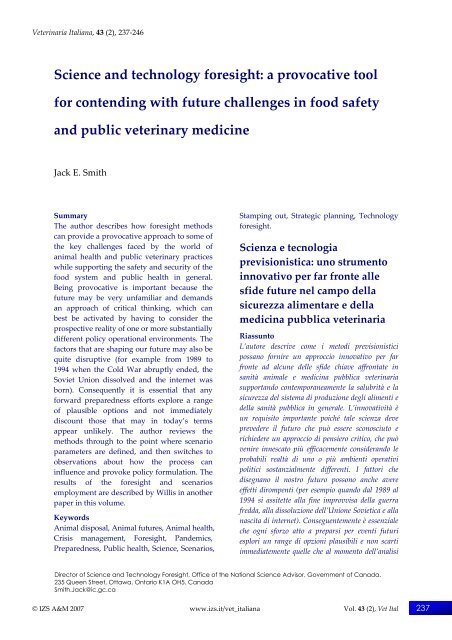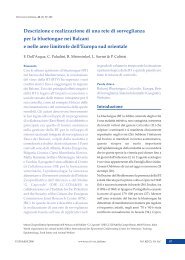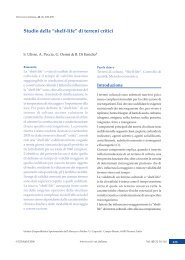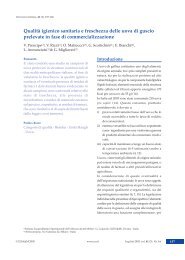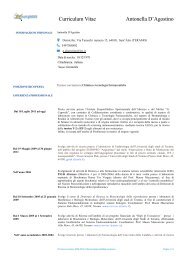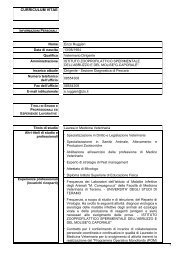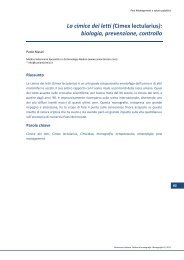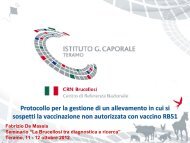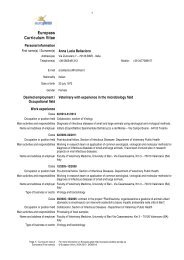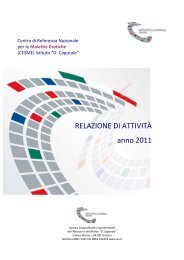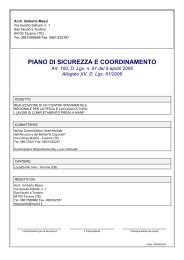Science and technology foresight: a provocative tool for contending ...
Science and technology foresight: a provocative tool for contending ...
Science and technology foresight: a provocative tool for contending ...
You also want an ePaper? Increase the reach of your titles
YUMPU automatically turns print PDFs into web optimized ePapers that Google loves.
Veterinaria Italiana, 43 (2), 237-246<br />
<strong>Science</strong> <strong>and</strong> <strong>technology</strong> <strong><strong>for</strong>esight</strong>: a <strong>provocative</strong> <strong>tool</strong><br />
<strong>for</strong> <strong>contending</strong> with future challenges in food safety<br />
<strong>and</strong> public veterinary medicine<br />
Jack E. Smith<br />
Summary<br />
The author describes how <strong><strong>for</strong>esight</strong> methods<br />
can provide a <strong>provocative</strong> approach to some of<br />
the key challenges faced by the world of<br />
animal health <strong>and</strong> public veterinary practices<br />
while supporting the safety <strong>and</strong> security of the<br />
food system <strong>and</strong> public health in general.<br />
Being <strong>provocative</strong> is important because the<br />
future may be very unfamiliar <strong>and</strong> dem<strong>and</strong>s<br />
an approach of critical thinking, which can<br />
best be activated by having to consider the<br />
prospective reality of one or more substantially<br />
different policy operational environments. The<br />
factors that are shaping our future may also be<br />
quite disruptive (<strong>for</strong> example from 1989 to<br />
1994 when the Cold War abruptly ended, the<br />
Soviet Union dissolved <strong>and</strong> the internet was<br />
born). Consequently it is essential that any<br />
<strong>for</strong>ward preparedness ef<strong>for</strong>ts explore a range<br />
of plausible options <strong>and</strong> not immediately<br />
discount those that may in today’s terms<br />
appear unlikely. The author reviews the<br />
methods through to the point where scenario<br />
parameters are defined, <strong>and</strong> then switches to<br />
observations about how the process can<br />
influence <strong>and</strong> provoke policy <strong>for</strong>mulation. The<br />
results of the <strong><strong>for</strong>esight</strong> <strong>and</strong> scenarios<br />
employment are described by Willis in another<br />
paper in this volume.<br />
Keywords<br />
Animal disposal, Animal futures, Animal health,<br />
Crisis management, Foresight, P<strong>and</strong>emics,<br />
Preparedness, Public health, <strong>Science</strong>, Scenarios,<br />
Stamping out, Strategic planning, Technology<br />
<strong><strong>for</strong>esight</strong>.<br />
Scienza e tecnologia<br />
previsionistica: uno strumento<br />
innovativo per far fronte alle<br />
sfide future nel campo della<br />
sicurezza alimentare e della<br />
medicina pubblica veterinaria<br />
Riassunto<br />
L’autore descrive come i metodi previsionistici<br />
possano <strong>for</strong>nire un approccio innovativo per far<br />
fronte ad alcune delle sfide chiave affrontate in<br />
sanità animale e medicina pubblica veterinaria<br />
support<strong>and</strong>o contemporaneamente la salubrità e la<br />
sicurezza del sistema di produzione degli alimenti e<br />
della sanità pubblica in generale. L’innovatività è<br />
un requisito importante poiché tale scienza deve<br />
prevedere il futuro che può essere sconosciuto e<br />
richiedere un approccio di pensiero critico, che può<br />
venire innescato più efficacemente consider<strong>and</strong>o le<br />
probabili realtà di uno o più ambienti operativi<br />
politici sostanzialmente differenti. I fattori che<br />
disegnano il nostro futuro possono anche avere<br />
effetti dirompenti (per esempio qu<strong>and</strong>o dal 1989 al<br />
1994 si assitette alla fine improvvisa della guerra<br />
fredda, alla dissoluzione dell’Unione Sovietica e alla<br />
nascita di internet). Conseguentemente è essenziale<br />
che ogni s<strong>for</strong>zo atto a preparsi per eventi futuri<br />
esplori un range di opzioni plausibili e non scarti<br />
immediatemente quelle che al momento dell’analisi<br />
Director of <strong>Science</strong> <strong>and</strong> Technology Foresight, Office of the National <strong>Science</strong> Advisor, Government of Canada,<br />
235 Queen Street, Ottawa, Ontario K1A OH5, Canada<br />
Smith.Jack@ic.gc.ca<br />
© IZS A&M 2007 www.izs.it/vet_italiana Vol. 43 (2), Vet Ital 237
<strong>Science</strong> <strong>and</strong> <strong>technology</strong> <strong><strong>for</strong>esight</strong>: a <strong>provocative</strong> <strong>tool</strong> <strong>for</strong> <strong>contending</strong><br />
with future challenges in food safety <strong>and</strong> public veterinary medicine<br />
Jack E. Smith<br />
appaiono improbabili. L’autore passa in rassegna i<br />
metodi esamin<strong>and</strong>o direttamente il punto dove i<br />
parametri dello scenario sono definiti, e quindi<br />
osserva come il processo può influenzare e creare<br />
diverse linee politiche. I risultati della previsione e<br />
gli scenari di impiego sono descritti da Willis in un<br />
altro lavoro in questo volume.<br />
Parole chiave<br />
Distruzione animale, Gestione crisi, Il futuro<br />
degli animali, P<strong>and</strong>emia, Pianificazione<br />
strategica, Preparazione, Previsione, Salute<br />
animale, Sanità pubblica, Scenari, Scienza,<br />
Stamping out, Tecnologia previsionistica.<br />
Introduction<br />
Strategic readiness <strong>for</strong> difficult situations<br />
involving public authorities can have both<br />
short-term <strong>and</strong> long-term implications. When<br />
ensuring the safety <strong>and</strong> security of its citizens<br />
by managing responses to received threats <strong>and</strong><br />
challenging events, governments are also held<br />
responsible <strong>for</strong> looking ahead to avoid real<br />
dangers that may not be readily apparent in<br />
the intermediate turmoil of near-term crisis<br />
response <strong>and</strong> mitigative actions. Just as<br />
importantly, in the interests of long-term<br />
preparedness, they must nurture both<br />
protective <strong>and</strong> adaptive capacities by<br />
developing the necessary thinking to anticipate<br />
change <strong>and</strong> unexpected events. While<br />
negotiating external <strong>and</strong> internal <strong>for</strong>ces <strong>and</strong><br />
taking a <strong>for</strong>ward-looking view to meet future<br />
challenges, governments are better prepared if<br />
they can reduce uncertainty <strong>and</strong> increase<br />
strategic options available to them <strong>and</strong> their<br />
citizens.<br />
Since opportunities are not often apparent<br />
when staff members are entrenched in the<br />
daily administration of specific duties <strong>and</strong><br />
long-st<strong>and</strong>ing paradigms, national governments<br />
require the dynamism of diverse <strong>and</strong><br />
strategic stakeholder groups in focusing on<br />
<strong><strong>for</strong>esight</strong> initiatives in an interactive real-time<br />
manner.<br />
Government <strong><strong>for</strong>esight</strong> operates predominantly<br />
at the national level <strong>and</strong> is designed to increase<br />
strategic preparedness. It often focuses on<br />
identifying possible directions <strong>for</strong> <strong>technology</strong><br />
<strong>and</strong> science programmes by providing the<br />
decision-making process with research,<br />
development <strong>and</strong> communication strategies<br />
that will benefit future policy. Foresight, in<br />
approaching uncertainty from the outside-in,<br />
attempts to broaden the perception of an<br />
organisation <strong>and</strong> to challenge assumptions<br />
through more external <strong>and</strong> objective analysis<br />
towards a deeper level of learning <strong>and</strong><br />
underst<strong>and</strong>ing of complex systems than that<br />
normally prevalent in the policy environment<br />
which can often succumb to inside-out<br />
thinking. By focusing on uncertainties,<br />
analysing trends <strong>and</strong> exploring driving <strong>for</strong>ces<br />
<strong>and</strong> risks from a future perspective, the steps<br />
that should be taken in the immediate future to<br />
ensure greater flexibility, knowledge <strong>and</strong><br />
scope <strong>for</strong> action can be identified. Making<br />
better strategic decisions <strong>and</strong> more agile yet<br />
anticipatory plans in a rapidly changing world<br />
is the goal, rather than to predict the future.<br />
In this context, influencing present day actions<br />
<strong>and</strong> decisions, including funding <strong>and</strong> setting<br />
priorities on vision building, is a key objective<br />
in a world that is changing so fast that it has<br />
made the rational planning approaches that<br />
many organisations use ineffective, because<br />
they are based on the tenets of relative stability<br />
over a relatively long period of time.<br />
Foresight is neither a plan nor a <strong>for</strong>ecast<br />
because each implies a clear preference to the<br />
exclusion of other options that may be<br />
plausible. Foresight is also not the same as a<br />
policy or a prediction <strong>for</strong> the same reason.<br />
Instead, <strong><strong>for</strong>esight</strong> is designed to ensure<br />
preparedness <strong>for</strong> diverse contingencies. The<br />
goal of <strong><strong>for</strong>esight</strong> <strong>and</strong> contingency planning is<br />
to develop a range of prospective, plausible or<br />
possible futures that an individual or<br />
organisation may have to contend with,<br />
employing both analysis <strong>and</strong> imagination in a<br />
systematic way. The overarching aim is to<br />
build a better quality of life by being prepared<br />
to see the opportunities <strong>for</strong> meaningful<br />
innovation (Fig. 1).<br />
World of change <strong>and</strong> surprise<br />
In a world that is full of surprises, it is<br />
increasingly important to incorporate<br />
238 Vol. 43 (2), Vet Ital www.izs.it/vet_italiana © IZS A&M 2007
Jack E. Smith<br />
<strong>Science</strong> <strong>and</strong> <strong>technology</strong> <strong><strong>for</strong>esight</strong>: a <strong>provocative</strong> <strong>tool</strong> <strong>for</strong> <strong>contending</strong><br />
with future challenges in food safety <strong>and</strong> public veterinary medicine<br />
contingency planning <strong>and</strong> to rehearse<br />
preparedness capacities, while at the same<br />
time breaking down the boundaries that limit<br />
the perceptions of key actors. It is easy to<br />
become stuck in a present reality that seems<br />
rather stable <strong>and</strong> com<strong>for</strong>table, while change<br />
happens ‘somewhere else’. Technological<br />
innovation is accelerating at a rapid pace on a<br />
global basis <strong>and</strong> it continues to play a<br />
fundamental role in shaping international<br />
<strong>for</strong>eign policy <strong>and</strong> global trade, along with<br />
competitive practices.<br />
A set of strategic <strong>tool</strong>s <strong>for</strong> anticipating the<br />
fundamental uncertainty of the future, to<br />
become more prepared <strong>for</strong> diverse challenges<br />
with adequate lead time. These <strong>tool</strong>s help us …<br />
• examine prospective developments in the 5-25 year<br />
horizon<br />
• underst<strong>and</strong> the range of key factors <strong>and</strong> drivers of<br />
change<br />
• accommodate risk, contingency <strong>and</strong> diversity<br />
• anticipate multiple, plausible futures<br />
• highlight emerging opportunities <strong>and</strong> threats<br />
• offer a rehearsal <strong>for</strong> potential critical challenges<br />
• create transition strategies to move towards<br />
preferred futures<br />
Figure 1<br />
How <strong><strong>for</strong>esight</strong> <strong>tool</strong>s can assist in long-term<br />
planning horizons<br />
Used to brief clients<br />
Source: Office of the National <strong>Science</strong> Advisor<br />
Over the past twenty-five years, the challenges<br />
of the HIV/AIDS epidemic, the end of<br />
apartheid in South Africa, an increase in<br />
terrorism, the explosive growth of the internet,<br />
the human genome project <strong>and</strong> the end of the<br />
Cold War all took place; most policy observers<br />
were unable to anticipate such events. Some<br />
<strong><strong>for</strong>esight</strong> practitioners, however, had already<br />
considered what action to take if confronted by<br />
similar situations. As early as 1985-1988, the<br />
Shell Group Planning scenario specialists were<br />
examining factors that were portending the<br />
Cold War conclusion <strong>and</strong> the onset of a new<br />
cycle of surprises connected with global<br />
climate change <strong>and</strong> ecological sustainability.<br />
Peter Schwartz provides a more recent similar<br />
view of <strong><strong>for</strong>esight</strong>-able circumstances in<br />
Inevitable surprises (4).<br />
The animal health challenge <strong>for</strong><br />
Canada<br />
Recently, the economic fallout from severe<br />
acute respiratory syndrome (SARS) <strong>for</strong> Canada<br />
was unexpected <strong>and</strong> costly. This was a real<br />
alert call <strong>for</strong> Canada, as some estimates of lost<br />
time, cancelled tourism <strong>and</strong> extra security<br />
costs incurred in Toronto <strong>and</strong> throughout<br />
Canada as result of SARS reached as much as<br />
US$1 billion (1). Globally, since the discovery<br />
of avian influenza in Asia in 2003, the world<br />
public health authorities have been on a<br />
p<strong>and</strong>emic alert, with substantial new resources<br />
being made available by most governments to<br />
increase preparedness <strong>and</strong> augment<br />
monitoring <strong>and</strong> vaccine supplies.<br />
Lingering in the background remains the<br />
strategy of ‘stamping out’ where both<br />
responsible as well as frightened governments,<br />
or at least their public health authorities, seek<br />
to ensure that they are not complacent in the<br />
face of major health threats. ‘Stamping out’<br />
refers to the practice of public authorities<br />
engaging in mass destruction <strong>and</strong> disposal of<br />
animals exposed or potentially exposed to<br />
diseases, especially zoonotic diseases that can<br />
leap from animals to humans.<br />
This is the context in which the Office of<br />
<strong>Science</strong> <strong>and</strong> Technology (S&T) Foresight first<br />
became involved in a <strong><strong>for</strong>esight</strong> project <strong>for</strong><br />
animal health in the autumn of 2004. At that<br />
time, there had already been some preliminary<br />
meetings between four key countries,<br />
Australia, Canada, New Zeal<strong>and</strong> <strong>and</strong> the<br />
United States, known as the ‘Quadrilateral<br />
Group’, where animal exports represent high<br />
profile elements in the total export economy.<br />
These countries concluded that they needed to<br />
not only work more closely together but also to<br />
investigate how they might reduce their<br />
vulnerability <strong>and</strong> capacity <strong>for</strong> rapid, safe <strong>and</strong><br />
eco-friendly responses to the next crisis.<br />
Consequently, in early 2005, a strategic group<br />
of Canadian <strong>and</strong> United States animal health<br />
<strong>and</strong> public health officials, educators <strong>and</strong><br />
practitioners was convened at Michigan State<br />
© IZS A&M 2007 www.izs.it/vet_italiana Vol. 43 (2), Vet Ital 239
<strong>Science</strong> <strong>and</strong> <strong>technology</strong> <strong><strong>for</strong>esight</strong>: a <strong>provocative</strong> <strong>tool</strong> <strong>for</strong> <strong>contending</strong><br />
with future challenges in food safety <strong>and</strong> public veterinary medicine<br />
Jack E. Smith<br />
University in East Lansing, Michigan, to<br />
develop a scoping framework <strong>for</strong> animal<br />
health <strong><strong>for</strong>esight</strong> (3).<br />
The previous decade had witnessed several<br />
high profile incidents where animal health<br />
issues caused local <strong>and</strong> national populations to<br />
be concerned – most notably in the United<br />
Kingdom where foot <strong>and</strong> mouth disease <strong>and</strong><br />
bovine spongi<strong>for</strong>m encephalopathy (BSE) or<br />
‘mad cow disease’ were perceived as<br />
endangering the food system <strong>and</strong> posing a<br />
threat to the human population.<br />
Foresight attempts to place the focus on the<br />
real drivers of a problem <strong>and</strong> to identify the<br />
areas of greatest impact <strong>and</strong> uncertainty,<br />
because that is where both the surprises <strong>and</strong><br />
most of the solutions will probably come from.<br />
The way that <strong><strong>for</strong>esight</strong> provokes thinking in<br />
terms of preparedness or approaches to this<br />
type of difficult situation is first to distinguish<br />
what factors are in fact driving the situation<br />
<strong>and</strong> which are the principal trends that every<br />
nation or player may have to contend with but<br />
equally be unable to alter. It then examines a<br />
range of prospective wildcards or shocks that<br />
could stress the system.<br />
The United Kingdom Joint Doctrine <strong>and</strong><br />
Concepts Centre of the Defence Ministry is a<br />
leading proponent of differentiating drivers<br />
from trends <strong>and</strong> shocks. Figure 2 illustrates<br />
how <strong><strong>for</strong>esight</strong> is applied by that Centre to the<br />
scoping of a threatened environment.<br />
In Table I, the bold entries indicate how animal<br />
health concerns represent an important factor<br />
within a larger list of the macro trends derived<br />
from S&T in part or in their entirety, <strong>and</strong> the<br />
resulting major uncertainties.<br />
Situating the present <strong>and</strong> its vulnerabilities is a<br />
critical first step when approaching <strong><strong>for</strong>esight</strong>.<br />
This step commences at the macro level as<br />
indicated in Table I.<br />
Most <strong><strong>for</strong>esight</strong> processes then follow a threepronged<br />
approach. The first approach relies<br />
upon developing some consensus or alignment<br />
around the most critical drivers/uncertainties.<br />
A diverging set of scenarios is designed to<br />
capture the effects of trends, drivers <strong>and</strong><br />
shocks in multiple boundary conditions <strong>for</strong><br />
prospective policy challenges. Secondly,<br />
participants are asked to develop <strong>and</strong> address<br />
a series of ‘challenge questions’ that provide a<br />
clear focus on the specific issues that need to<br />
be addressed.<br />
• Critical drivers <strong>and</strong> uncertainties: i.e. discernible<br />
patterns that are causing change, e.g. global<br />
society <strong>and</strong> security, political peometry, resources<br />
dem<strong>and</strong>s, major S&T developments <strong>and</strong> their societal<br />
impacts, new international agreements <strong>and</strong> strategic<br />
S&T investments<br />
These are areas that change from year to year <strong>and</strong><br />
may be amenable to skakeholders’ actions<br />
• Strategic trends: i.e. factors that shift as a fresult of<br />
change patterns, e.g. decline in state sovereignty,<br />
complex military challenges, new politico-military<br />
alliances, Islam-West antagonism, space <strong>and</strong> cyber<br />
conflicts, more nuclear equipped nations, more<br />
humanitarian dem<strong>and</strong>s, inter-state migration, failing<br />
states proliferate, powerful new technologies<br />
These are the broad impacts of change <strong>and</strong> most<br />
stakeholders are powerless to affect the trend with<br />
actions <strong>and</strong> they tend to endure as influential shapers<br />
<strong>for</strong> at least 4-5 years<br />
• Possible shocks: i.e. wild card, high impact, low<br />
probability events that alter the fundamentals,<br />
e.g. Gulf stream shift, fusion power, major earthquakes/<br />
tsunamis, infectious p<strong>and</strong>emic, fertility decline, secular<br />
reversal, cyber collapse, human ageing breakthrough,<br />
solar flare, asteroid impacts, financial collapse,<br />
sustained deflation, powerful new technologies<br />
Figure 2<br />
Differentiating drivers from trends <strong>and</strong><br />
shocks – applying <strong><strong>for</strong>esight</strong> to the scoping of a<br />
threatened environment<br />
Source: United Kingdom Ministry of Defence<br />
Development Concepts <strong>and</strong> Doctrine Centre (5)<br />
Finally, participants are then required to backcast,<br />
from the future time of the scenarios to<br />
the present time, to derive policy<br />
recommendations <strong>and</strong> inflection points where<br />
strategic decisions, in terms of the issues <strong>and</strong><br />
challenge questions, could have enabled or<br />
altered policy directions <strong>and</strong> outcomes.<br />
Figure 3 outlines <strong><strong>for</strong>esight</strong> steps that are taken<br />
to elaborate the detailed application of<br />
<strong><strong>for</strong>esight</strong> methodology to broad policy issues.<br />
The animal health group started the <strong><strong>for</strong>esight</strong><br />
process by outlining the situation it was facing<br />
in terms of several key issues or critical<br />
problem areas that it felt the <strong><strong>for</strong>esight</strong> process<br />
should address or at least take into account.<br />
An interesting point is that most of these issues<br />
are also persistent challenges that link the past,<br />
present <strong>and</strong> future. When grouped into<br />
240 Vol. 43 (2), Vet Ital www.izs.it/vet_italiana © IZS A&M 2007
Jack E. Smith<br />
<strong>Science</strong> <strong>and</strong> <strong>technology</strong> <strong><strong>for</strong>esight</strong>: a <strong>provocative</strong> <strong>tool</strong> <strong>for</strong> <strong>contending</strong><br />
with future challenges in food safety <strong>and</strong> public veterinary medicine<br />
Table I<br />
Macro <strong><strong>for</strong>esight</strong> trends <strong>and</strong> uncertainties<br />
Macro shaping trends<br />
Integration, miniaturisation of <strong>technology</strong><br />
Globalisation of trade, capital, terror<br />
Harmonisation of st<strong>and</strong>ards, protocols<br />
Migration, multi-culturalism of populations<br />
Intensification <strong>and</strong> differentiation of wealth<br />
Bi-polarisation of religious values <strong>and</strong> secular evolution<br />
Trans<strong>for</strong>mation of infrastructure systems<br />
Virtualisation, digitisation <strong>and</strong> integration of business<br />
models, communications, entertainment, education<br />
Automation <strong>and</strong> customisation of production<br />
Acceleration of knowledge services as an economic<br />
driver<br />
Proliferation, adaptation, rapid circulation of disease<br />
Major uncertainties surround<br />
Individualism versus community<br />
Sustainable development dynamics<br />
Access <strong>and</strong> use of weapons of mass destruction,<br />
including bioterrorism<br />
Outward-looking communities versus isolationism<br />
Financial market consistency <strong>and</strong> per<strong>for</strong>mance<br />
New diseases, viral spread, containment<br />
Consequences of global warming<br />
Impact of changing fertility rates<br />
Food system sustainability – dependence upon<br />
animal protein<br />
common or interdependent areas, they become<br />
the key lenses through which the complexity<br />
of this environment can be better understood<br />
<strong>and</strong> managed.<br />
They also signify the lead into the ‘drivers <strong>and</strong><br />
challenges questions’ that will follow. The<br />
group discussion begins to provide a context<br />
<strong>for</strong> the selection of drivers that will eventually<br />
shape the scenarios, which are selected to<br />
prompt more focused exchanges about the<br />
range of futures with which the group should<br />
be prepared to contend (Table II).<br />
Following this step, the drivers of change <strong>and</strong><br />
the challenge to the group regarding the<br />
drivers that carry the greatest uncertainties<br />
<strong>and</strong> impacts, are examined. As <strong><strong>for</strong>esight</strong> is<br />
ideally an outside-looking-in process in which<br />
an atmosphere of preparedness is created <strong>for</strong><br />
the world that may be coming rather than the<br />
one we may prefer, it is important to start at<br />
the level of global change drivers. Table III<br />
provides a summary of several factors that<br />
cause global tension <strong>and</strong> societal uncertainty.<br />
The initial list of drivers that were identified<br />
by the East Lansing Group is given in Table IV.<br />
S&T <strong><strong>for</strong>esight</strong> relies on correctly interpreting<br />
S&T change drivers <strong>and</strong> the causal <strong>and</strong><br />
temporal factors involved with change when<br />
future social, economic <strong>and</strong> political realities<br />
are involved. There<strong>for</strong>e, it is not only highly<br />
analytical but also speculative exercise that<br />
incorporates imagination <strong>and</strong> creativity.<br />
Figure 3<br />
Foresight steps taken to elaborate the<br />
application of <strong><strong>for</strong>esight</strong> methodology to<br />
broad policy issues<br />
© IZS A&M 2007 www.izs.it/vet_italiana Vol. 43 (2), Vet Ital 241
<strong>Science</strong> <strong>and</strong> <strong>technology</strong> <strong><strong>for</strong>esight</strong>: a <strong>provocative</strong> <strong>tool</strong> <strong>for</strong> <strong>contending</strong><br />
with future challenges in food safety <strong>and</strong> public veterinary medicine<br />
Jack E. Smith<br />
Table II<br />
Broad socio-economic issues <strong>and</strong> change perspectives (contributed by expert panel to<br />
prompt focused exchanges on the selection of critical drivers)<br />
Scoping issues<br />
• Many emerging diseases are zoonotic<br />
• Historic precedents exist of some success, ‘the way we’ve done it in the past <strong>and</strong> it works – to a degree’<br />
• Stamping out is socially <strong>and</strong> economically unacceptable; seen as a crude, blunt instrument<br />
• Health <strong>and</strong> emotional toll on farmers<br />
• Public perception that the crisis is out of control; experts are ‘lost’<br />
• Inadequate communications from politicians to public; politicians reporting from out-of-date science<br />
• Some alternatives are unacceptable in some cultures<br />
• Economic cost, market <strong>and</strong> global trade losses<br />
• Poor risk accounting to the public; the public expects zero risk<br />
• Media portrayal of issue<br />
• Clashes of opinion on issue amongst media, public, government, agriculture<br />
• Inability of the sector to do appropriate, differentiated crisis management<br />
• Logistics are unmanageable – size, scope, transportation; sector capacities <strong>for</strong> management are exhausted<br />
• Negative environmental impact<br />
• Limited expertise worldwide to deal with emerging problems<br />
• Non-compliance <strong>and</strong> non-reporting by municipalities, producers, owners, animal rights advocates<br />
• Animal rights, environmental impact challenges, legal issues<br />
• Agricultural evolution, transition to large-scale operations means an increase in the size <strong>and</strong> scope of the<br />
problem<br />
• Jurisdictional conflicts<br />
• Visibility of the issue leads to vulnerability to terrorist threats<br />
• Creation of winners <strong>and</strong> losers<br />
• Eradication implies failure of prevention<br />
Table III<br />
Societal change drivers<br />
Driver categories<br />
• Demographics – population changes<br />
• <strong>Science</strong> <strong>and</strong> <strong>technology</strong> – knowledge<br />
<strong>and</strong> innovations<br />
• Environment – carrying capacity, global<br />
ecology<br />
• Attitudes, values, beliefs – from opinion to<br />
religion<br />
• Global economy – interdependent<br />
markets, trade<br />
• Governance <strong>and</strong> institutions – political<br />
organisation<br />
• Evident threats – to civilisation <strong>and</strong><br />
infrastructure<br />
How science <strong>and</strong> <strong>technology</strong><br />
<strong><strong>for</strong>esight</strong> works<br />
S&T <strong><strong>for</strong>esight</strong> provides planners <strong>and</strong> decisionmakers<br />
with a process <strong>and</strong> a product to help<br />
identify potential links between current<br />
policies <strong>and</strong> actions <strong>and</strong> future outcomes. Its<br />
value lies in pushing the boundaries to capture<br />
broadly based thinking on a long-range time<br />
horizon. It can help policy makers <strong>and</strong><br />
planners identify possible threats <strong>and</strong><br />
opportunities at an earlier stage, by illustrating<br />
how barely recognisable trends <strong>and</strong> drivers, or<br />
‘weak signals’, can have important<br />
consequences in the future.<br />
For example, during the 1960s, the first<br />
discoveries of laser light <strong>and</strong> atomic scale<br />
measurement became available as computers<br />
<strong>and</strong> new scientific instrumentation developed.<br />
242 Vol. 43 (2), Vet Ital www.izs.it/vet_italiana © IZS A&M 2007
Jack E. Smith<br />
<strong>Science</strong> <strong>and</strong> <strong>technology</strong> <strong><strong>for</strong>esight</strong>: a <strong>provocative</strong> <strong>tool</strong> <strong>for</strong> <strong>contending</strong><br />
with future challenges in food safety <strong>and</strong> public veterinary medicine<br />
Table IV<br />
Initial list of drivers identified by the East Lansing Group<br />
Critical change drivers <strong>for</strong> animal health<br />
• Availability of new technologies, e.g. rapid diagnostics, breakthroughs in medicine, increased<br />
underst<strong>and</strong>ing of disease<br />
• Too expensive to continue on the present course<br />
• Link between human <strong>and</strong> animal health<br />
• Growing resistance of animal producers who believe their prosperity <strong>and</strong> quality of life are being<br />
destroyed; it is becoming a political pressure<br />
• Environmental problem of waste<br />
• Societal pressure – reaction to killing, spending of public funds, disruption to tourism, etc. – leads to<br />
political pressure<br />
• Marginalisation of veterinary decision-makers<br />
• Agency capacity is at the point of exhaustion<br />
• Logistics become more complicated as farms get larger<br />
• Loss of confidence by investors, public, government <strong>and</strong> in experts <strong>and</strong> policy makers<br />
• Waste of protein in light of global human hunger problem<br />
• Industry wants to ‘keep meat on the menu’<br />
• Public dem<strong>and</strong> <strong>for</strong> zero risk<br />
• Absence of coordination of in<strong>for</strong>mation <strong>technology</strong><br />
• Increased hypersensitivity of media to the problems<br />
• Absence of a coordinated global response<br />
• Recognition of macro-economic impact of the industry<br />
• Threat of bioterrorism<br />
• Need <strong>for</strong> coordinated, differentiated approaches<br />
Soon the new fields of photonics <strong>and</strong><br />
nano<strong>technology</strong> began to emerge as<br />
prospective foci <strong>for</strong> S&T. By the 1980s,<br />
applications of lasers were having an impact<br />
on medicine, electronics <strong>and</strong> manufacturing<br />
<strong>and</strong> nano-scale engineering devices were being<br />
imagined. Another 20 years later, real progress<br />
<strong>and</strong> significant changes <strong>for</strong> materials,<br />
computing, biohealth <strong>and</strong> science itself are<br />
now apparent in business <strong>and</strong> society from<br />
these two early signals in relation to future<br />
S&T.<br />
In the context of animal health, there have<br />
been several signals that have portended major<br />
threats (mainly in third world circumstances)<br />
as large <strong>and</strong> rapid growth populations <strong>and</strong><br />
impoverished governments have tried to cope<br />
with disease spread amidst difficult<br />
circumstances. Even in the developed world,<br />
regular stamping-out situations occur, such as<br />
the cull of 19 million poultry in British<br />
Columbia in Canada in the spring of 2003 (2).<br />
Adapting these types of threatening signals to<br />
scenarios has also created some very<br />
contentious situations that highlighted the<br />
enormous extent of negative impacts that<br />
could at least in theory follow (6). The Proteus<br />
scenario posits a future world characterised by<br />
a persistent, global, highly contagious disease<br />
that changes the way international travel,<br />
health, commerce <strong>and</strong> many other public<br />
functions are per<strong>for</strong>med. Clearly nobody<br />
wants to have to face a possible threat<br />
becoming a reality that would require massive<br />
societal isolation.<br />
The challenge <strong>for</strong> animal health <strong><strong>for</strong>esight</strong> <strong>and</strong><br />
animal population managers, <strong>and</strong><br />
organisations with the ability to recognise the<br />
link between these ‘weak signals’ <strong>and</strong> potential<br />
threats or opportunities, is there<strong>for</strong>e how to be<br />
better prepared <strong>and</strong> ready <strong>for</strong> rapid response.<br />
It is also how to make good research <strong>and</strong><br />
development choices well in advance, how to<br />
develop contingency plans <strong>and</strong> how to become<br />
more agile <strong>and</strong> effective in decision-making.<br />
© IZS A&M 2007 www.izs.it/vet_italiana Vol. 43 (2), Vet Ital 243
<strong>Science</strong> <strong>and</strong> <strong>technology</strong> <strong><strong>for</strong>esight</strong>: a <strong>provocative</strong> <strong>tool</strong> <strong>for</strong> <strong>contending</strong><br />
with future challenges in food safety <strong>and</strong> public veterinary medicine<br />
Jack E. Smith<br />
Foresight planning focuses on a long-term<br />
planning horizon of between five <strong>and</strong> twentyfive<br />
years <strong>and</strong> aims to explore options <strong>and</strong><br />
possibilities among a wide range of future<br />
scenarios.<br />
Creating challenge questions<br />
A <strong><strong>for</strong>esight</strong> exercise typically targets one issue<br />
or problem <strong>and</strong> examines a number of possible<br />
futures, or scenarios, that might arise from it.<br />
A multi-disciplinary team of thinkers is<br />
assembled to tackle the issue, usually through<br />
a series of workshops, panels or conferences.<br />
The team, over time <strong>and</strong> in a structured<br />
process, shares current knowledge of emerging<br />
research, ideas <strong>and</strong> trends to first construct a<br />
set of ‘challenge questions’ <strong>and</strong> then develop<br />
multiple, plausible scenarios, describing<br />
alternate future states. The team can then look<br />
<strong>for</strong>ward <strong>and</strong> back between the present <strong>and</strong><br />
future states to identify likely issues <strong>and</strong><br />
developments that would contribute to each<br />
future scenario.<br />
For example, a ten-year <strong>for</strong>ward scenario that<br />
anticipates greater ecological damage from<br />
unrestricted emissions because of a failure to<br />
manage automobile efficiencies <strong>and</strong> other<br />
atmospheric pollutants could pose a question<br />
<strong>for</strong> back-casting: what preparations in the<br />
period 2005-2010 would have been necessary<br />
to avoid the situation being experienced in the<br />
2015 time period, <strong>and</strong> what advice would the<br />
team wish to give to policy makers to mitigate<br />
the most negative impacts of this scenario<br />
given its plausibility? A <strong><strong>for</strong>esight</strong> exercise<br />
might yield up to ten different scenarios of this<br />
nature <strong>for</strong> the future, some positive or hopeful,<br />
some negative or subject to major uncertainties<br />
– each dependent on triggers <strong>and</strong> developments<br />
that might plausibly come to pass over<br />
the time horizon of the exercise.<br />
In the course of a <strong><strong>for</strong>esight</strong> exercise, other <strong>tool</strong>s<br />
may also be employed or incorporated into the<br />
scenario planning. These <strong>tool</strong>s can include<br />
literature reviews, <strong>technology</strong> mapping, web<br />
surveys, Delphi iterative issue polls <strong>and</strong><br />
challenge dialogues.<br />
Table V lists the main ‘challenge questions’<br />
that were developed by the project team<br />
following the discussion by the East Lansing<br />
Group <strong>for</strong> the three subsequent meetings held<br />
in Calgary, Minneapolis <strong>and</strong> Ottawa later in<br />
2005.<br />
Scenario parameters<br />
A crucial stage of the <strong><strong>for</strong>esight</strong> process is<br />
reducing the list of drivers to those that will be<br />
used to frame the scenarios. This is a<br />
challenging process in itself as participants<br />
must weigh many factors <strong>and</strong> settle upon<br />
those they believe will really make the<br />
difference between heading in one direction,<br />
which becomes the preferred or normative<br />
scenario, <strong>and</strong> having to cope with three other<br />
very different options, all of which may have<br />
significant associated problems.<br />
In the case of the animal health group, the<br />
choice evolved into a discussion of how<br />
important both S&T <strong>and</strong> public<br />
communications would be in the future <strong>and</strong><br />
what strategies would be necessary to realise<br />
the preferred option, even if one might have to<br />
experience some of the effects of the other<br />
options along the way to success. The story of<br />
these strategies <strong>and</strong> their application to the<br />
future of animal health management is<br />
discussed by Willis in this volume (7). The<br />
scenario parameters are presented in Figure 4.<br />
Conclusion <strong>and</strong> lessons learned<br />
Foresight should be seen as a useful learning<br />
<strong>tool</strong> <strong>for</strong> policy researchers, as a <strong>for</strong>ward<br />
planning <strong>and</strong> exploration asset <strong>for</strong> policy<br />
advisors <strong>and</strong> as a context setter <strong>for</strong> policy<br />
makers. By identifying early alerts <strong>and</strong><br />
emergent developments, <strong><strong>for</strong>esight</strong> can provide<br />
the agility required to enhance the resilience of<br />
policy framing, <strong>and</strong> can exp<strong>and</strong> the range <strong>and</strong><br />
robustness of policy options.<br />
244 Vol. 43 (2), Vet Ital www.izs.it/vet_italiana © IZS A&M 2007
Jack E. Smith<br />
<strong>Science</strong> <strong>and</strong> <strong>technology</strong> <strong><strong>for</strong>esight</strong>: a <strong>provocative</strong> <strong>tool</strong> <strong>for</strong> <strong>contending</strong><br />
with future challenges in food safety <strong>and</strong> public veterinary medicine<br />
Table V<br />
Animal health <strong><strong>for</strong>esight</strong> challenge questions<br />
Key lens<br />
In<strong>for</strong>mation<br />
management <strong>and</strong><br />
skills<br />
Trade <strong>and</strong><br />
economics<br />
Policy <strong>and</strong> regulation<br />
Advances in science<br />
<strong>and</strong> communications<br />
Issue dimension<br />
1. Knowledge sharing <strong>and</strong> emergency response to animal disease crises in 2020 are both<br />
highly effective on a global scale<br />
Describe how this is so, from the perspective of all stakeholders (industry, researchers,<br />
government) in terms of <strong>technology</strong> <strong>and</strong> people skills.<br />
2. What new skills <strong>and</strong> training priorities <strong>for</strong> personnel have made the greatest impact<br />
since 2005 in the creation <strong>and</strong> implementation of innovative alternatives to mass animal<br />
destruction?<br />
3. In 2020, every animal in the food supply is individually tracked<br />
What are the most important attributes of this tracking system <strong>and</strong> why has it proved to<br />
be so beneficial?<br />
1. How have changes in global livestock production increased or decreased economic<br />
incentives <strong>for</strong> mass animal destruction as a disease control strategy?<br />
2. What changes in international trade agreements or st<strong>and</strong>ards have enabled countries<br />
to respond to <strong>for</strong>eign animal disease outbreaks without using mass animal destruction?<br />
3. In 2020, under what conditions do we let nature run its course during a <strong>for</strong>eign animal<br />
disease outbreak?<br />
1. What changes in the roles <strong>and</strong> responsibilities of industry, government, consumers <strong>and</strong><br />
politicians have been necessary to achieve a cooperative, science-based, effective<br />
<strong>and</strong> fully understood process to establish policy <strong>for</strong> the management of animal<br />
disease?<br />
2. What policy changes have been necessary to create a paradigm of animal health<br />
optimisation?<br />
3. What changes have been necessary to allow a wide menu of choices <strong>for</strong> responding<br />
to animal diseases while maximising the benefits <strong>for</strong> the global public <strong>and</strong> the<br />
economic viability of industry?<br />
1. What advances set the stage <strong>for</strong> effective disease risk management without mass<br />
animal destruction?<br />
2. How have advances in communication <strong>tool</strong>s <strong>and</strong> strategies reduced public anxiety<br />
over animal disease risk management?<br />
3. How have influential leaders from various sectors been engaged in critical issues<br />
regarding animal <strong>and</strong> human health?<br />
Level of animal<br />
optimisation<br />
Low (totally<br />
MAD)<br />
Public anxiety<br />
High (stressed)<br />
Public anxiety<br />
Low (stressed)<br />
Level of animal<br />
optimisation<br />
High (many<br />
alteratives to<br />
MAD)<br />
Kenneth J. Andrews Animal Health Foresight – 20<br />
MAD mass animal destruction-disposal<br />
Figure 4<br />
Driver axes <strong>for</strong> scenario development<br />
In a world where innovation has become<br />
faster, global in scope <strong>and</strong> more<br />
technologically dependent, the broadly based<br />
insights that <strong><strong>for</strong>esight</strong> examines help create<br />
agility <strong>and</strong> preparedness which in turn can be<br />
highly effective as inputs to innovation policy.<br />
With these insights in mind <strong>and</strong> because<br />
<strong><strong>for</strong>esight</strong> encourages participants to contend<br />
with plausible, contingent scenarios <strong>and</strong><br />
evaluate their prospective policy implications,<br />
it is proposed that <strong><strong>for</strong>esight</strong> become a valued<br />
provocateur <strong>for</strong> government <strong>and</strong> industry<br />
managers of complex issues <strong>and</strong> diverse<br />
challenges, such as those posed by animal<br />
disease within a highly interconnected <strong>and</strong><br />
often vulnerable food system.<br />
© IZS A&M 2007 www.izs.it/vet_italiana Vol. 43 (2), Vet Ital 245
<strong>Science</strong> <strong>and</strong> <strong>technology</strong> <strong><strong>for</strong>esight</strong>: a <strong>provocative</strong> <strong>tool</strong> <strong>for</strong> <strong>contending</strong><br />
with future challenges in food safety <strong>and</strong> public veterinary medicine<br />
Jack E. Smith<br />
References<br />
1. CBC News 2003. The economic impact of SARS. CBC News In Depth, CBC News Online updated<br />
8 July 2003 (www.cbc.ca/news/background/sars/economicimpact.html accessed on 29 March<br />
2007).<br />
2. CBC News 2003. WHO increases monitoring of BC bird flu outbreak. CBC News Canada, last<br />
updated: 6 April 2004 (www.cbc.ca/canada/story/2004/04/06/birds040406.html accessed on<br />
29 March 2007).<br />
3. Office of the National <strong>Science</strong> Advisor 2005. Animal health <strong><strong>for</strong>esight</strong> scoping report, East Lansing,<br />
31 January-1 February. Office of the National <strong>Science</strong> Advisor, Foresight Directorate, Ottawa, 18 pp.<br />
4. Schwartz P. 2003. Inevitable surprises. Gotham Books, New York, 248 pp.<br />
5. United Kingdom Ministry of Defence (MOD) 2003. Strategic trends: methodology, key findings <strong>and</strong><br />
shocks. United Kingdom MOD Shrivenham, Development Concepts <strong>and</strong> Doctrine Centre, Swindon,<br />
29 pp.<br />
6. United States National Reconnaissance Office 1999. Amazon plague, Proteus scenarios, 1999<br />
(www.proteuscanada.org accessed on 29 March 2007).<br />
7. Willis N.G. 2007. The animal health <strong><strong>for</strong>esight</strong> project. In Alternatives to animal disposal, including the<br />
use of <strong><strong>for</strong>esight</strong> <strong>technology</strong> <strong>and</strong> agri-intelligence (N.G. Willis, ed.). Vet Ital, 43 (2), 247-256.<br />
246 Vol. 43 (2), Vet Ital www.izs.it/vet_italiana © IZS A&M 2007


